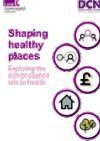This publication presents case study examples showing how district councils have improved the health of their local areas.
In Victorian times, local government pioneered and introduced the provision of clean water, universal education, parks and open spaces, decent public housing, food inspection and the detection and treatment of infectious diseases. In the twenty-first century, we are building new partnerships and taking on a critical leadership role in improving the public’s health.
The modern day health challenges are significant. One in five children in Year 6 are overweight or obese. Most people will reach a retirement age with a disability. Sick days cost our economy £14 billion a year. Long-term conditions account for 70 per cent of hospital bed days. The country faces a rising tide of need, as people live longer but spend more of those years in ill-health, largely because of preventable chronic diseases.
The Health and Social Care Act 2012 reforms have radically shifted power to local authorities, empowering them to invest and innovate to improve the health of their communities. The reforms reflect a confidence that local communities are best placed to respond to local needs, rather than central government.
District councils are not formally responsible for public health as detailed in the Health and Social Care Act 2012, but they still have a huge role in it. They are providers of key services which have a direct impact on the social determinants of health, such as housing, planning, leisure, recreation and environmental health which directly impact on the health of the population.

- Published by:
-
LGA & DCN
- Reference code:
-
22.37
